Spatiotemporal Heterogeneity of Influencing Factors for Urban Spaces Suitable for Running Workouts Based on Multi-Source Big Data
Abstract
1. Introduction
2. Literature View
2.1. Sports and Health
2.2. Running and the Built Environment
2.3. Suitable Running Space and Methodological Considerations
3. Materials and Methods
3.1. Study Area
3.2. Analytical Framework
3.3. Data
3.3.1. Running Trajectory Data
3.3.2. Natural Environment Data
3.3.3. Other Data
3.4. Variable Selection
3.4.1. Dependent Variable
3.4.2. Explanatory Variables
3.5. Research Methods
3.5.1. Stepwise Regression Method
3.5.2. Geographically and Temporally Weighted Regression (GTWR)
4. Results
4.1. Descriptive Statistics and Analysis
4.1.1. Spatial Morphology Analysis
4.1.2. Time-Frequency Preference Analysis
4.1.3. Variable Analysis
4.2. Variable Filtering
4.3. Spatiotemporal Heterogeneity Analysis of Running Trajectories
4.3.1. Empirical Results and Test of GTWR Model
4.3.2. Accessibility Factors
4.3.3. Diversity Factors
4.3.4. Comfort Factors
4.4. Integrated Analysis of Spatiotemporal Heterogeneity
4.4.1. Spatial Level
4.4.2. Time Level
5. Discussion and Limitations
5.1. Discussion
5.2. Limitations
6. Conclusions
- (1)
- Influencing factors: the influence of built environment elements (road class, green space distribution, and accessibility of facilities) on the selection of sports routes has significant spatial heterogeneity. Among them, the quality of the feeder road network, green space accessibility, and the internal environment of the residential area are the three most influential dimensions. It is noteworthy that the importance ranking of these influences differed significantly between restdays and rest days.
- (2)
- Spatial differentiation characteristics: The study area showed a clear pattern of four types of spatial differentiation: ① the city centre area showed a park-oriented exercise pattern in a high-density built-up environment, and there is a need to focus on improving the quality of footpaths and park running track facilities; ② the emerging development area showed a road-preferred characteristic in a low-density environment, and there is a need to optimise the exercise suitability of the secondary road network; ③ the ecological new area demonstrated a residential area-oriented exercise The ecological new areas show a residential oriented exercise pattern and urgently need to improve the community exercise facilities; ④ The urban fringe areas form a mixed pattern based on the water system and green space, and need to improve the connectivity of the secondary road network and the quality of the waterfront space. This spatial differentiation is closely related to the characteristics of the built environment, population density, and the distribution of facilities in each area.
- (3)
- In terms of time dynamics: restdays show obvious “residential proximity” characteristics, with fragmented distribution of exercise space; while rest days show “destination orientation” characteristics, forming cross-regional exercise networks. This difference reflects the differences in residents’ needs for exercise at different times of the day: restdays focus on convenience, while rest days pursue a variety of experiences.
Author Contributions
Funding
Data Availability Statement
Conflicts of Interest
References
- Nutbeam, D.; Lloyd, J.E. Understanding and responding to health literacy as a social determinant of health. Annu. Rev. Public Health 2021, 42, 159–173. [Google Scholar] [CrossRef]
- Zaman, S.; Mian, A.K.; Butt, F. Attitude of young students towards sports and physical activities. Glob. Manag. J. Acad. Corp. Stud. 2018, 8, 33–42. [Google Scholar]
- Kaczynski, A.T.; Potwarka, L.R.; Saelens, B.E. Association of park size, distance, and features with physical activity in neighborhood parks. Am. J. Public Health 2008, 98, 1451–1456. [Google Scholar] [CrossRef] [PubMed]
- Kazdin, A.E. Interventions in everyday life to improve mental health and reduce symptoms of psychiatric disorders. Am. Psychol. 2024, 79, 185. [Google Scholar] [CrossRef]
- Paluska, S.A.; Schwenk, T.L. Physical activity and mental health: Current concepts. Sports Med. 2000, 29, 167–180. [Google Scholar] [CrossRef]
- Quirk, H.; Bullas, A.; Haake, S.; Goyder, E.; Graney, M.; Wellington, C.; Copeland, R.; Reece, L.; Stevinson, C. Exploring the benefits of participation in community-based running and walking events: A cross-sectional survey of parkrun participants. BMC Public Health 2021, 21, 1978. [Google Scholar] [CrossRef] [PubMed]
- Mandeli, K. Public space and the challenge of urban transformation in cities of emerging economies: Jeddah case study. Cities 2019, 95, 102409. [Google Scholar] [CrossRef]
- Nuriddinov, A. Physical activity, health and environment. Am. J. Soc. Sci. Humanit. Res. 2023, 3, 189–200. [Google Scholar]
- Salvo, D.; Garcia, L.; Reis, R.S.; Stankov, I.; Goel, R.; Schipperijn, J.; Hallal, P.C.; Ding, D.; Pratt, M. Physical activity promotion and the United Nations sustainable development goals: Building synergies to maximize impact. J. Phys. Act. Health 2021, 18, 1163–1180. [Google Scholar] [CrossRef]
- Yancey, A.K.; Fielding, J.E.; Flores, G.R.; Sallis, J.F.; McCarthy, W.J.; Breslow, L. Creating a robust public health infrastructure for physical activity promotion. Am. J. Prev. Med. 2007, 32, 68–78. [Google Scholar] [CrossRef]
- Sallis, J.F.; Adams, M.A.; Ding, D. Physical activity and the built environment. In The Oxford Handbook of the Social Science of Obesity; Oxford University Press: Oxford, UK, 2011. [Google Scholar]
- Sallis, J.F.; Carlson, J.A.; Mignano, A.M.; Lemes, A.; Wagner, N. Trends in presentations of environmental and policy studies related to physical activity, nutrition, and obesity at Society of Behavioral Medicine, 1995–2010: A commentary to accompany the Active Living Research Supplement to Annals of Behavioral Medicine. Ann. Behav. Med. 2013, 45, 14–17. [Google Scholar] [CrossRef] [PubMed]
- Wang, L.; Jiang, X.; Cai, J. Healthy city planning: Insights from China. In Chinese Urban Planning and Construction: From Historical Wisdom to Modern Miracles; Springer: Berlin/Heidelberg, Germany, 2021; pp. 201–223. [Google Scholar]
- Committee, P.A.G.A. Physical Activity Guidelines Advisory Committee Report, 2008; US Department of Health and Human Services: Washington, DC, USA, 2008; p. A1-H14.
- Committee, P.A.G.A. Physical Activity Guidelines for Americans; US Department of Health and Human Services: Washington, DC, USA, 2008; pp. 15–34.
- Karusisi, N.; Bean, K.; Oppert, J.-M.; Pannier, B.; Chaix, B. Multiple dimensions of residential environments, neighborhood experiences, and jogging behavior in the RECORD Study. Prev. Med. 2012, 55, 50–55. [Google Scholar] [CrossRef] [PubMed]
- Zhang, C.; Gong, P. Healthy China: From words to actions. Lancet Public Health 2019, 4, e438–e439. [Google Scholar] [CrossRef] [PubMed]
- Dai, J.; Menhas, R. Sustainable development goals, sports and physical activity: The localization of health-related sustainable development goals through sports in China: A narrative review. Risk Manag. Healthc. Policy 2020, 13, 1419–1430. [Google Scholar] [CrossRef]
- Xiao, X.; Tan, F.T.C.; Lim, E.T.; Henningsson, S.; Vatrapu, R.; Hedman, J.; Tan, C.W.; Clemenson, T.; Mukkamala, R.R.; Van Hillegersberg, J. Sports digitalization: An overview and A research agenda. In Proceedings of the 38th International Conference on Information Systems, Atlanta, GA, USA, 10–13 December 2017. ICIS 2017, 2018. [Google Scholar]
- Liu, Y.; Hu, J.; Yang, W.; Luo, C. Effects of urban park environment on recreational jogging activity based on trajectory data: A case of Chongqing, China. Urban For. Urban Green. 2022, 67, 127443. [Google Scholar] [CrossRef]
- Peart, D.J.; Balsalobre-Fernández, C.; Shaw, M.P. Use of mobile applications to collect data in sport, health, and exercise science: A narrative review. J. Strength Cond. Res. 2019, 33, 1167–1177. [Google Scholar] [CrossRef]
- Wolf, I.D.; Wohlfart, T. Walking, hiking and running in parks: A multidisciplinary assessment of health and well-being benefits. Landsc. Urban Plan. 2014, 130, 89–103. [Google Scholar] [CrossRef]
- Yang, W.; Hu, J.; Liu, Y.; Guo, W. Examining the influence of neighborhood and street-level built environment on fitness jogging in Chengdu, China: A massive GPS trajectory data analysis. J. Transp. Geogr. 2023, 108, 103575. [Google Scholar]
- Shi, T.; Gao, F. Utilizing Multi-Source Geospatial Big Data to Examine How Environmental Factors Attract Outdoor Jogging Activities. Remote Sens. 2024, 16, 3056. [Google Scholar] [CrossRef]
- Yang, W.; Fei, J.; Li, Y.; Chen, H.; Liu, Y. Unraveling nonlinear and interaction effects of multilevel built environment features on outdoor jogging with explainable machine learning. Cities 2024, 147, 104813. [Google Scholar] [CrossRef]
- Yang, W.; Li, Y.; Liu, Y.; Fan, P.; Yue, W. Environmental factors for outdoor jogging in Beijing: Insights from using explainable spatial machine learning and massive trajectory data. Landsc. Urban Plan. 2024, 243, 104969. [Google Scholar] [CrossRef]
- Kaczynski, A.T.; Koohsari, M.J.; Stanis, S.A.W.; Bergstrom, R.; Sugiyama, T. Association of street connectivity and road traffic speed with park usage and park-based physical activity. Am. J. Health Promot. 2014, 28, 197–203. [Google Scholar] [CrossRef] [PubMed]
- Gladwell, V.F.; Brown, D.K.; Wood, C.; Sandercock, G.R.; Barton, J.L. The great outdoors: How a green exercise environment can benefit all. Extrem. Physiol. Med. 2013, 2, 3. [Google Scholar] [CrossRef]
- Edwards, P.; Tsouros, A.D. Promoting Physical Activity and Active Living in Urban Environments: The Role of Local Governments; WHO Regional Office Europe: Copenhagen, Denmark, 2006. [Google Scholar]
- Zhang, S.; Wang, Z.; Helbich, M.; Ettemaa, D. Assessing runners’ exposure to natural and built environments in the Netherlands: A descriptive assessment based on GPS tracking. Int. J. Environ. Health Res. 2024, 34, 2104–2123. [Google Scholar] [CrossRef]
- Wang, Y.; Han, Y.; Pu, L.; Jiang, B.; Yuan, S.; Xu, Y. A novel model for detecting urban fringe and its expanding patterns: An application in Harbin City, China. Land 2021, 10, 876. [Google Scholar] [CrossRef]
- Wang, X.; Bao, X.; Ge, Z.; Xi, J.; Zhao, Y. Identification and Redevelopment of Inefficient Residential Landuse in Urban Areas: A Case Study of Ring Expressway Area in Harbin City of China. Land 2024, 13, 1238. [Google Scholar] [CrossRef]
- Kabisch, N.; Kraemer, R. Physical activity patterns in two differently characterised urban parks under conditions of summer heat. Environ. Sci. Policy 2020, 107, 56–65. [Google Scholar] [CrossRef]
- Gao, J.; Shi, Y.; Zhang, H.; Chen, X.; Zhang, W.; Shen, W.; Xiao, T.; Zhang, Y. China Regional 250 m Normalized Difference Vegetation Index Data Set (2000–2022). Natl. Tibet. Plateau/Third Pole Environ. Data Cent. 2023, 2, 946–952. [Google Scholar]
- European Space Agency Sinergise. Copernicus Global Digital Elevation Model. 2021. [CrossRef]
- Li, X.; Hu, T.; Gong, P.; Du, S.; Chen, B.; Li, X.; Dai, Q. Mapping essential urban land use categories in Beijing with a fast area of interest (AOI)-based method. Remote Sens. 2021, 13, 477. [Google Scholar] [CrossRef]
- Cervero, R.; Kockelman, K. Travel demand and the 3Ds: Density, diversity, and design. Transp. Res. Part D Transp. Environ. 1997, 2, 199–219. [Google Scholar] [CrossRef]
- Pikora, T.; Giles-Corti, B.; Bull, F.; Jamrozik, K.; Donovan, R. Developing a framework for assessment of the environmental determinants of walking and cycling. Soc. Sci. Med. 2003, 56, 1693–1703. [Google Scholar] [CrossRef]
- Norman, P.; Pickering, C.M. Factors influencing park popularity for mountain bikers, walkers and runners as indicated by social media route data. J. Environ. Manag. 2019, 249, 109413. [Google Scholar] [CrossRef]
- Tegart, A.D. Runnability: Evaluation of Environmental Features Promoting Running; Simon Fraser University: Vancouver, BC, Canada, 2025. [Google Scholar]
- Sahani, R.; Bhuyan, P. Modelling pedestrian perspectives in evaluating satisfaction levels of urban roadway walking facilities. Transp. Res. Procedia 2020, 48, 2262–2279. [Google Scholar] [CrossRef]
- Maroko, A.R.; Maantay, J.A.; Sohler, N.L.; Grady, K.L.; Arno, P.S. The complexities of measuring access to parks and physical activity sites in New York City: A quantitative and qualitative approach. Int. J. Health Geogr. 2009, 8, 34. [Google Scholar] [CrossRef]
- Rapport, N.; Dawson, A. Home and movement: A polemic. In Migrants of Identity; Routledge: Oxfordshire, UK, 2021; pp. 19–38. [Google Scholar]
- Asgari Gandomani, R.; Rahimi, A.; Shahbazpour, L.; Jokar Arsanjani, J. Spatial Justice and Accessibility: Optimizing Sports Facility Allocation in Tehran. Land 2025, 14, 1318. [Google Scholar] [CrossRef]
- Ghalamro, S.S.; Bandarabad, A.; Shahabian, P. Investigating the Role of Spatial Diversity in Selecting Behavioral Patterns of Public Territory (Case Study: Zanjan’s Pedestrian Zone). J. Urban Manag. Energy Sustain. 2022, 3, 19–38. [Google Scholar]
- Ma, X.; Chau, C.K.; Lai, J.H.K. Critical factors influencing the comfort evaluation for recreational walking in urban street environments. Cities 2021, 116, 103286. [Google Scholar] [CrossRef]
- Teeuwen, R.; Milias, V.; Bozzon, A.; Psyllidis, A. How well do NDVI and OpenStreetMap data capture people’s visual perceptions of urban greenspace? Landsc. Urban Plan. 2024, 245, 105009. [Google Scholar] [CrossRef]
- Vernillo, G.; Giandolini, M.; Edwards, W.B.; Morin, J.-B.; Samozino, P.; Horvais, N.; Millet, G.Y. Biomechanics and physiology of uphill and downhill running. Sports Med. 2017, 47, 615–629. [Google Scholar] [CrossRef]
- Wheeler, B.W.; Lovell, R.; Higgins, S.L.; White, M.P.; Alcock, I.; Osborne, N.J.; Husk, K.; Sabel, C.E.; Depledge, M.H. Beyond greenspace: An ecological study of population general health and indicators of natural environment type and quality. Int. J. Health Geogr. 2015, 14, 17. [Google Scholar] [CrossRef]
- Shrestha, N. Detecting multicollinearity in regression analysis. Am. J. Appl. Math. Stat. 2020, 8, 39–42. [Google Scholar] [CrossRef]
- Huang, B.; Wu, B.; Barry, M. Geographically and temporally weighted regression for modeling spatio-temporal variation in house prices. Int. J. Geogr. Inf. Sci. 2010, 24, 383–401. [Google Scholar] [CrossRef]
- Brunsdon, C.; Fotheringham, A.S.; Charlton, M.E. Geographically weighted regression: A method for exploring spatial nonstationarity. Geogr. Anal. 1996, 28, 281–298. [Google Scholar] [CrossRef]
- O’Sullivan, D. Geographically weighted regression: The analysis of spatially varying relationships. Geogr. Anal. 2003, 35, 272–275. [Google Scholar] [CrossRef]
- Zhang, T.; Zhou, X.; Liu, X. Reliability analysis of slopes using the improved stochastic response surface methods with multicollinearity. Eng. Geol. 2020, 271, 105617. [Google Scholar] [CrossRef]
- Chuang, I.-T.; Benita, F.; Tunçer, B. Effects of urban park spatial characteristics on visitor density and diversity: A geolocated social media approach. Landsc. Urban Plan. 2022, 226, 104514. [Google Scholar] [CrossRef]
- Schrijnen, P.M. Infrastructure networks and red-green patterns in city regions. Landsc. Urban Plan. 2000, 48, 191–204. [Google Scholar] [CrossRef]
- Zhong, Q.; Li, B.; Chen, Y. How do different urban footpath environments affect the jogging preferences of residents of different genders? Empirical research based on trajectory data. Int. J. Environ. Res. Public Health 2022, 19, 14372. [Google Scholar] [CrossRef]
- Lo, A.-T.; Houston, D. How do compact, accessible, and walkable communities promote gender equality in spatial behavior? J. Transp. Geogr. 2018, 68, 42–54. [Google Scholar] [CrossRef]
- Wang, H.; Dai, X.; Wu, J.; Wu, X.; Nie, X. Influence of urban green open space on residents’ physical activity in China. BMC Public Health 2019, 19, 1093. [Google Scholar] [CrossRef] [PubMed]
- Wen, L.; Kenworthy, J.; Marinova, D. Higher density environments and the critical role of city streets as public open spaces. Sustainability 2020, 12, 8896. [Google Scholar] [CrossRef]
- Li, H.; Peng, J.; Yanxu, L.; Yi’na, H. Urbanization impact on landscape patterns in Beijing City, China: A spatial heterogeneity perspective. Ecol. Indic. 2017, 82, 50–60. [Google Scholar] [CrossRef]
- Song, Y.; Chen, B.; Kwan, M.-P. How does urban expansion impact people’s exposure to green environments? A comparative study of 290 Chinese cities. J. Clean. Prod. 2020, 246, 119018. [Google Scholar] [CrossRef]

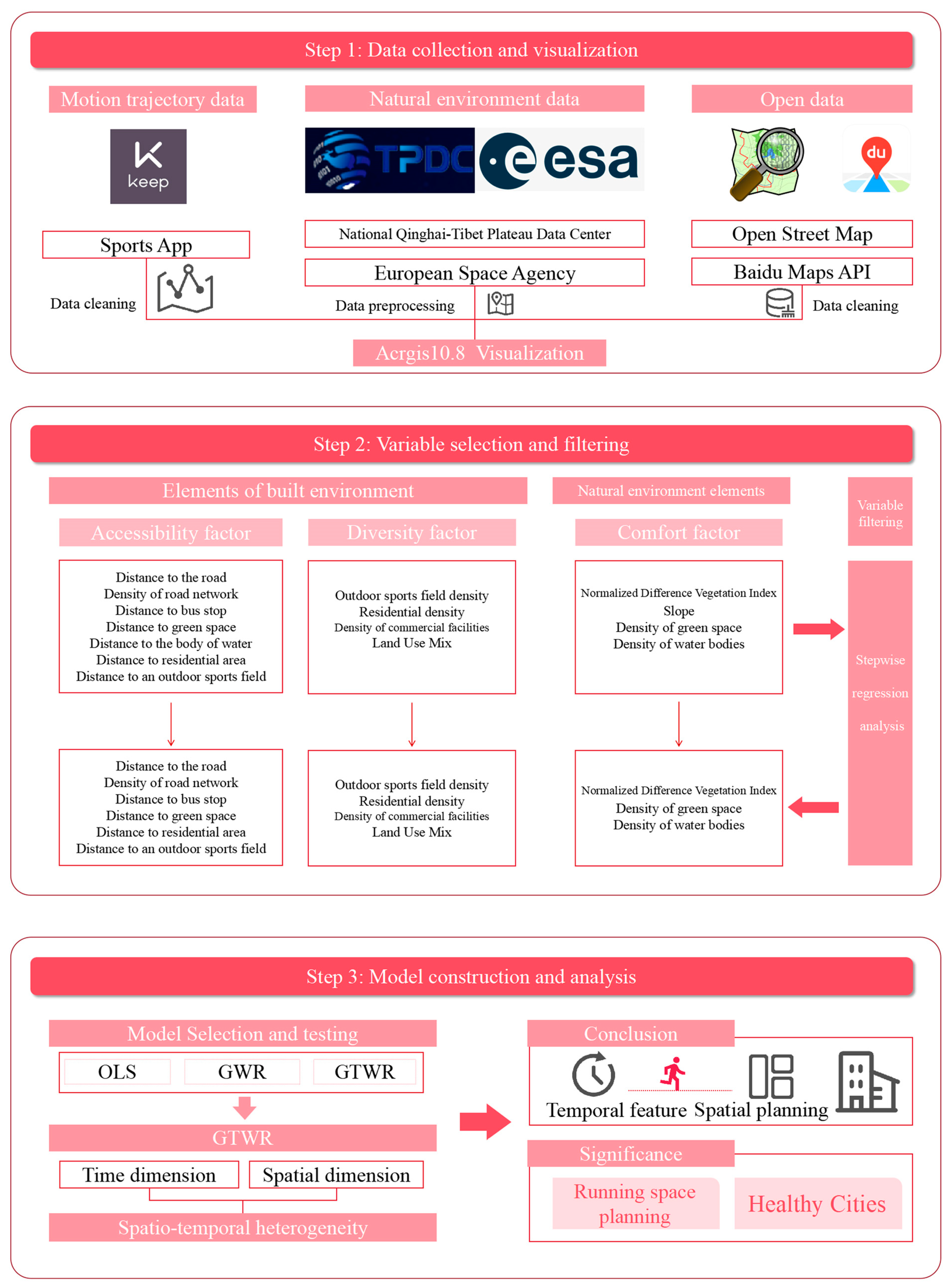
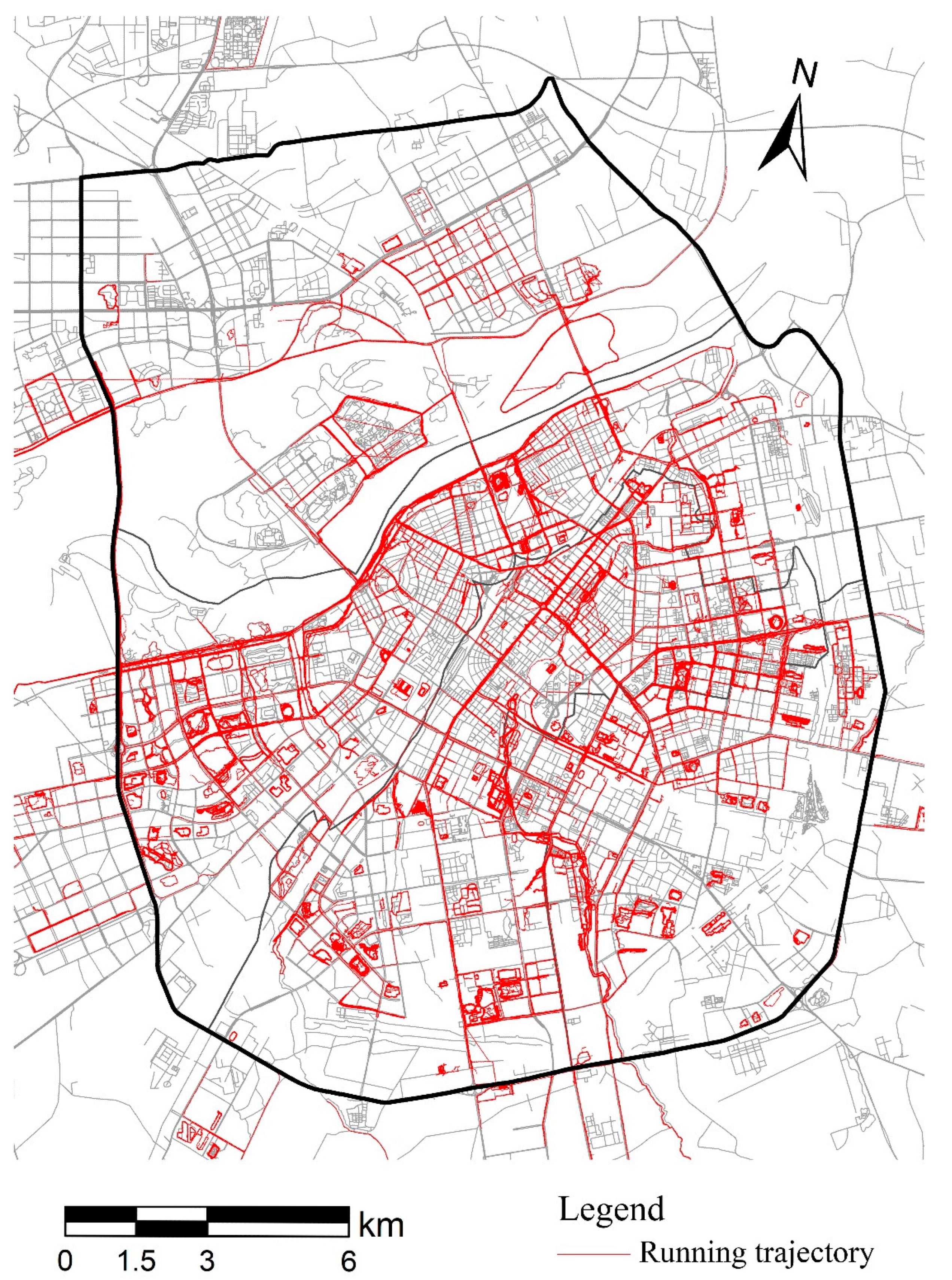
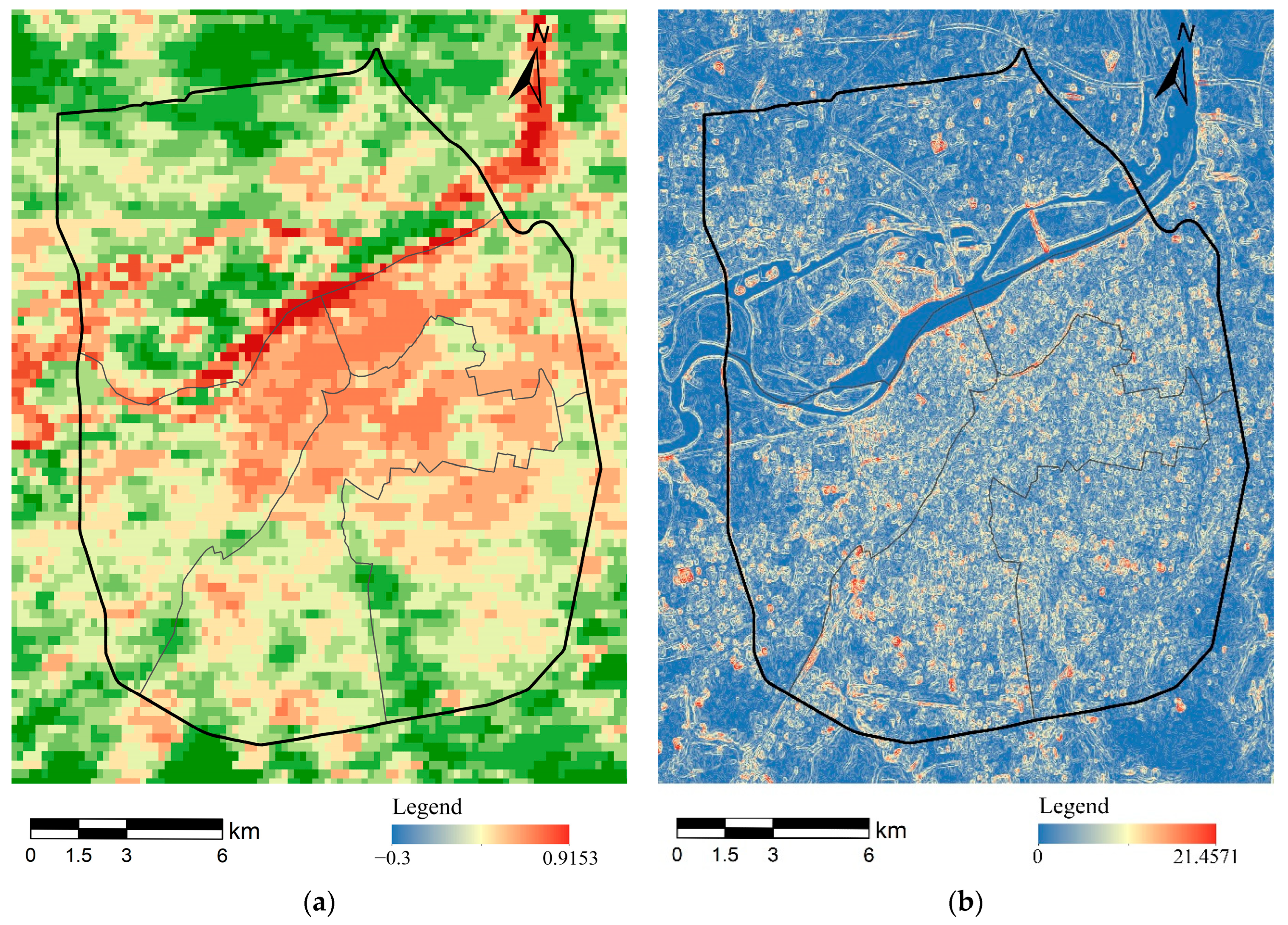

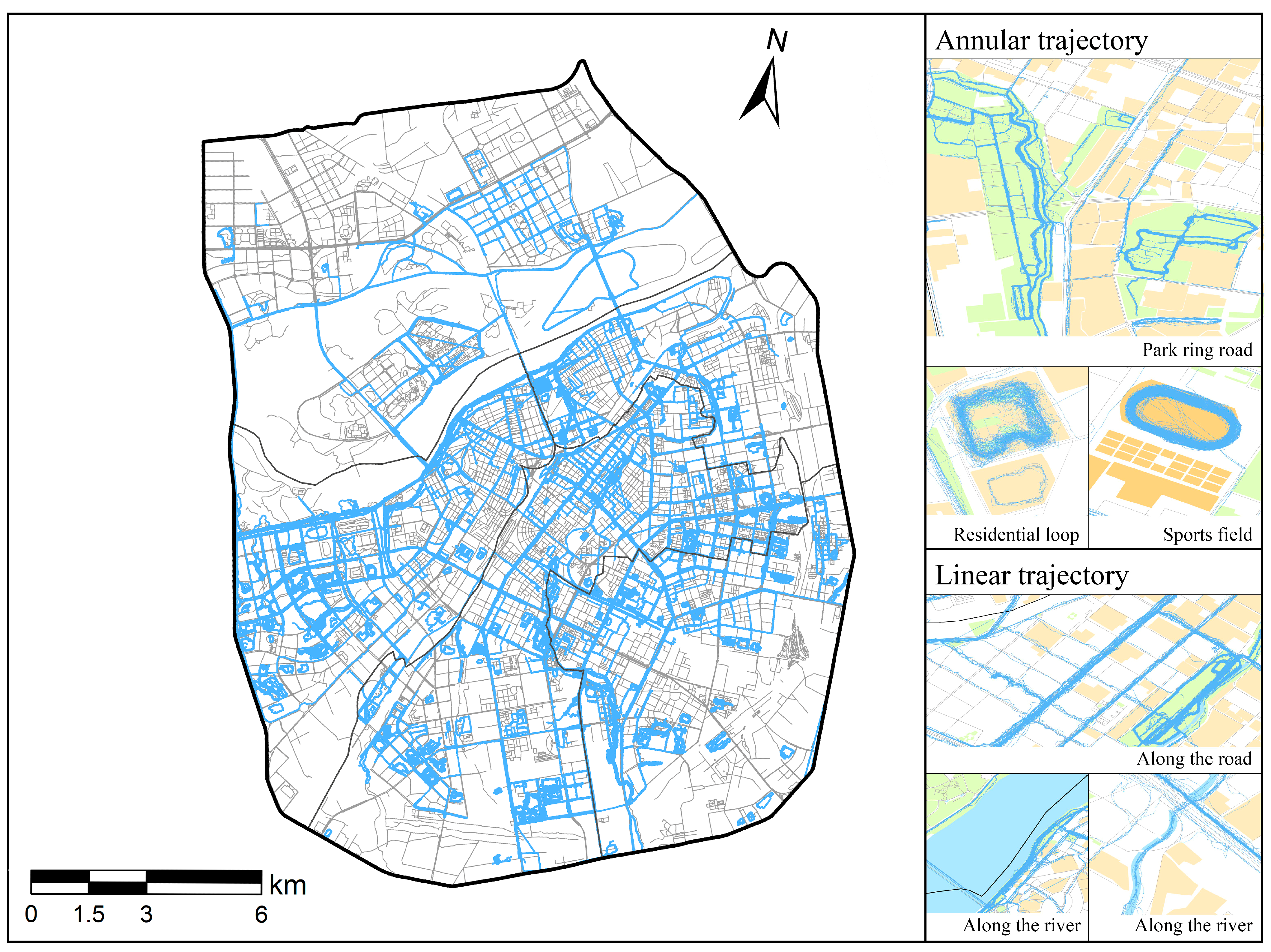


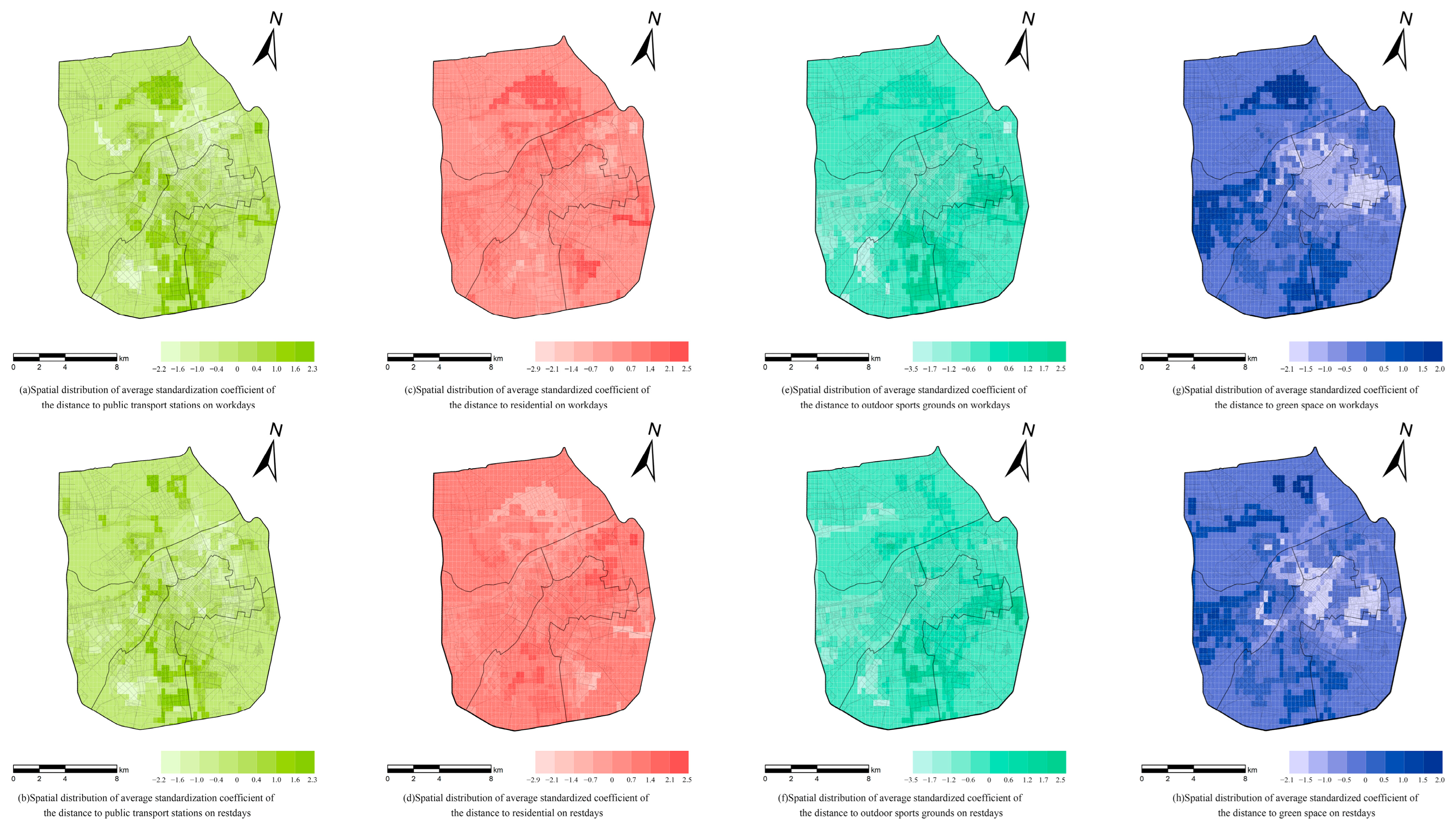
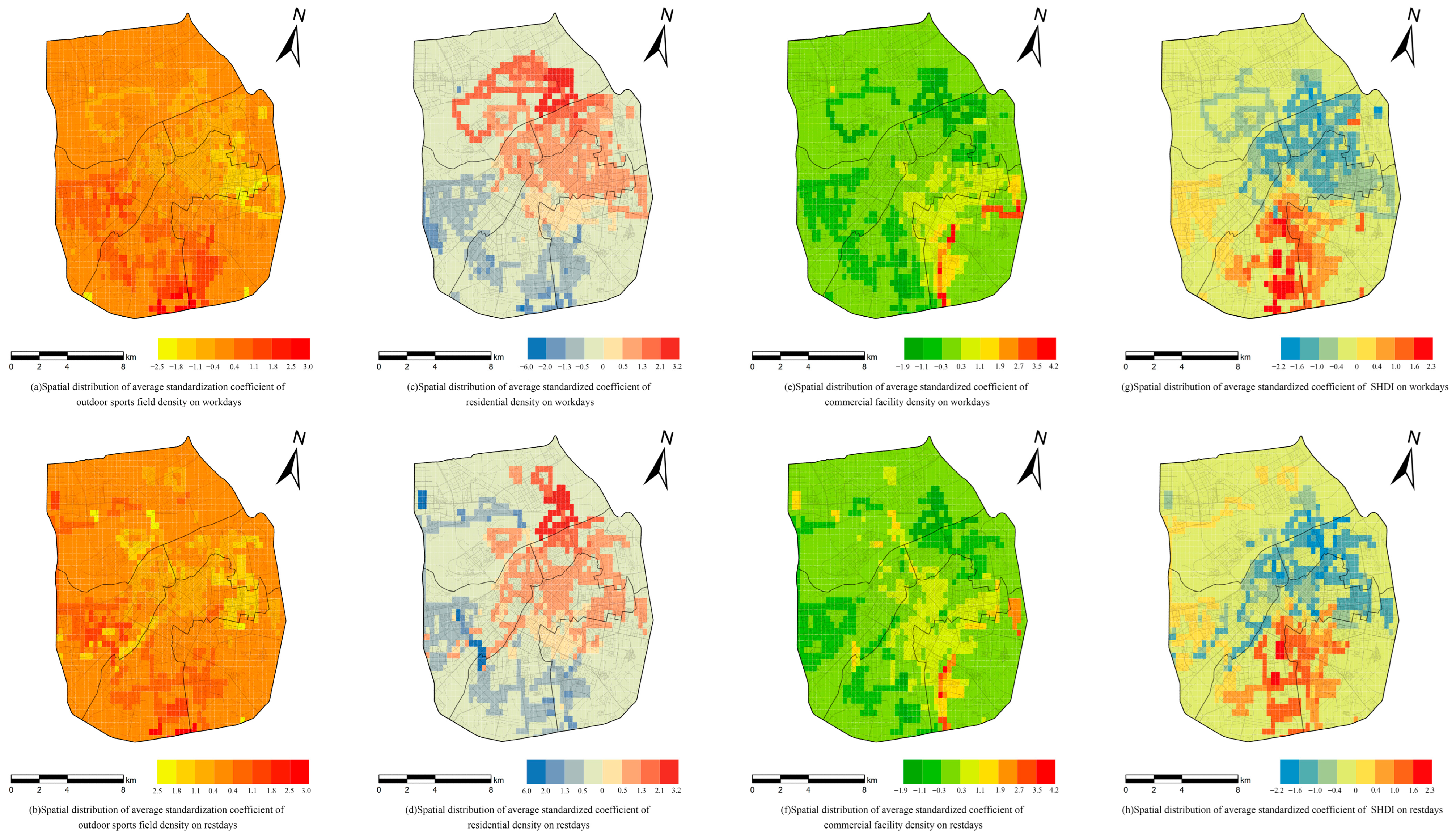

| Category | Variables | Description | |
|---|---|---|---|
| Accessibility | Distance to the road | Distance to the freeway | The mean of the closest distance between trajectory points on each trajectory and roads of different classes (m) |
| Distance to the main road | |||
| Distance to the secondary road | |||
| Distance to the bypass | |||
| Density of road network | The mean of the road network density at the location of the trajectory point on each trajectory (km/km2) | ||
| Distance to bus stop | The mean distance from the trajectory point on each trajectory to the nearest subway station, bus stop (m) | ||
| Distance to green space | The mean distance from the trajectory point on each trajectory to the nearest green space (m) | ||
| Distance to the body of water | The mean distance from the trajectory point on each trajectory to the nearest body of water (m) | ||
| Distance to residential area | The mean distance from the trajectory point on each trajectory to the nearest residential area (m) | ||
| Distance to an outdoor sports field | The mean distance from the trajectory point on each trajectory to the nearest sports facility (m) | ||
| Variety | Outdoor sports field density | The mean number of outdoor sports field points per unit area | |
| Residential density | Mean number of residential area points per unit area | ||
| Density of commercial facilities | Mean number of commercial facility points per unit area | ||
| Land Use Mix (SHDI) | The mean value of the POI Shannon entropy | ||
| Comfort | Normalized Difference Vegetation Index (NDVI) | The average of the standardized differential vegetation index | |
| Slope | The mean of the maximum rate of change in the direction of each unit and its adjacent units | ||
| Density of green space | The mean number of green space points per unit area | ||
| Density of water bodies | The mean number of points of a water body per unit area | ||
| Category | Variables | Mean | S.D. | |
|---|---|---|---|---|
| Dependent Variable | Walking and running motion track density | 262.837 | 188.120 | |
| Explained variable | ||||
| Accessibility | Distance to road | Distance to the freeway | 755.782 | 534.086 |
| Distance to the main road | 212.692 | 234.499 | ||
| Distance to the secondary road | 358.974 | 309.949 | ||
| Distance to the bypass | 251.755 | 174.258 | ||
| Density of road network | 221.825 | 0.018 | ||
| Distance to bus stop | 145.798 | 221.825 | ||
| Distance to green space | 947.657 | 145.798 | ||
| Distance to the body of water | 136.403 | 947.657 | ||
| Distance to residential area | 579.955 | 136.403 | ||
| Distance to an outdoor sports field | 2.448 | 579.955 | ||
| Variety | Outdoor sports field density | 7.234 | 2.448 | |
| Residential density | 391.099 | 7.234 | ||
| Density of commercial facilities | 1.683 | 391.099 | ||
| Land Use Mix (SHDI) | 0.415 | 1.683 | ||
| Comfort | Normalized Difference Vegetation Index (NDVI) | 1.901 | 0.415 | |
| Slope | 755.782 | 1.901 | ||
| Density of green space | 5.285 | 4.714 | ||
| Density of water bodies | 0.806 | 1.035 | ||
| Category | Variables | Coef. | Sig. | VIF | |
|---|---|---|---|---|---|
| Accessibility | Distance to road | Distance to the freeway | 0.091 | 0.000 | 1.741 |
| Distance to the main road | 0.121 | 0.000 | 2.662 | ||
| Distance to the secondary road | 0.052 | 0.000 | 1.966 | ||
| Distance to the bypass | 0.117 | 0.000 | 1.617 | ||
| Density of road network | −0.309 | 0.000 | 1.621 | ||
| Distance to bus stop | −0.296 | 0.000 | 4.238 | ||
| Distance to green space | −0.304 | 0.000 | 1.797 | ||
| Distance to the body of water | - | - | - | ||
| Distance to residential area | −0.072 | 0.002 | 3.196 | ||
| Distance to an outdoor sports field | −0.066 | 0.000 | 2.131 | ||
| Variety | Outdoor sports field density | −0.042 | 0.017 | 1.847 | |
| Residential density | 0.273 | 0.000 | 3.778 | ||
| Density of commercial facilities | 0.149 | 0.000 | 3.466 | ||
| Land Use Mix (SHDI) | −0.184 | 0.000 | 2.611 | ||
| Comfort | Normalized Difference Vegetation Index (NDVI) | 0.374 | 0.000 | 1.756 | |
| Slope | - | - | - | ||
| Density of green space | 0.228 | 0.000 | 2.866 | ||
| Density of water bodies | 0.038 | 0.043 | 2.063 | ||
| R2 | 0.448 | ||||
| Adj R2 | 0.445 | ||||
| Significance F amount of change | 0.043 | ||||
| AICc | R2 | |
|---|---|---|
| OLS | 42,307.7 | 0.447891 |
| GWR | 35,785.3 | 0.934207 |
| GTWR | 35,632.9 | 0.935108 |
Disclaimer/Publisher’s Note: The statements, opinions and data contained in all publications are solely those of the individual author(s) and contributor(s) and not of MDPI and/or the editor(s). MDPI and/or the editor(s) disclaim responsibility for any injury to people or property resulting from any ideas, methods, instructions or products referred to in the content. |
© 2025 by the authors. Published by MDPI on behalf of the International Society for Photogrammetry and Remote Sensing. Licensee MDPI, Basel, Switzerland. This article is an open access article distributed under the terms and conditions of the Creative Commons Attribution (CC BY) license (https://creativecommons.org/licenses/by/4.0/).
Share and Cite
Di, X.; Zhang, J. Spatiotemporal Heterogeneity of Influencing Factors for Urban Spaces Suitable for Running Workouts Based on Multi-Source Big Data. ISPRS Int. J. Geo-Inf. 2025, 14, 366. https://doi.org/10.3390/ijgi14090366
Di X, Zhang J. Spatiotemporal Heterogeneity of Influencing Factors for Urban Spaces Suitable for Running Workouts Based on Multi-Source Big Data. ISPRS International Journal of Geo-Information. 2025; 14(9):366. https://doi.org/10.3390/ijgi14090366
Chicago/Turabian StyleDi, Xinyu, and Jun Zhang. 2025. "Spatiotemporal Heterogeneity of Influencing Factors for Urban Spaces Suitable for Running Workouts Based on Multi-Source Big Data" ISPRS International Journal of Geo-Information 14, no. 9: 366. https://doi.org/10.3390/ijgi14090366
APA StyleDi, X., & Zhang, J. (2025). Spatiotemporal Heterogeneity of Influencing Factors for Urban Spaces Suitable for Running Workouts Based on Multi-Source Big Data. ISPRS International Journal of Geo-Information, 14(9), 366. https://doi.org/10.3390/ijgi14090366






